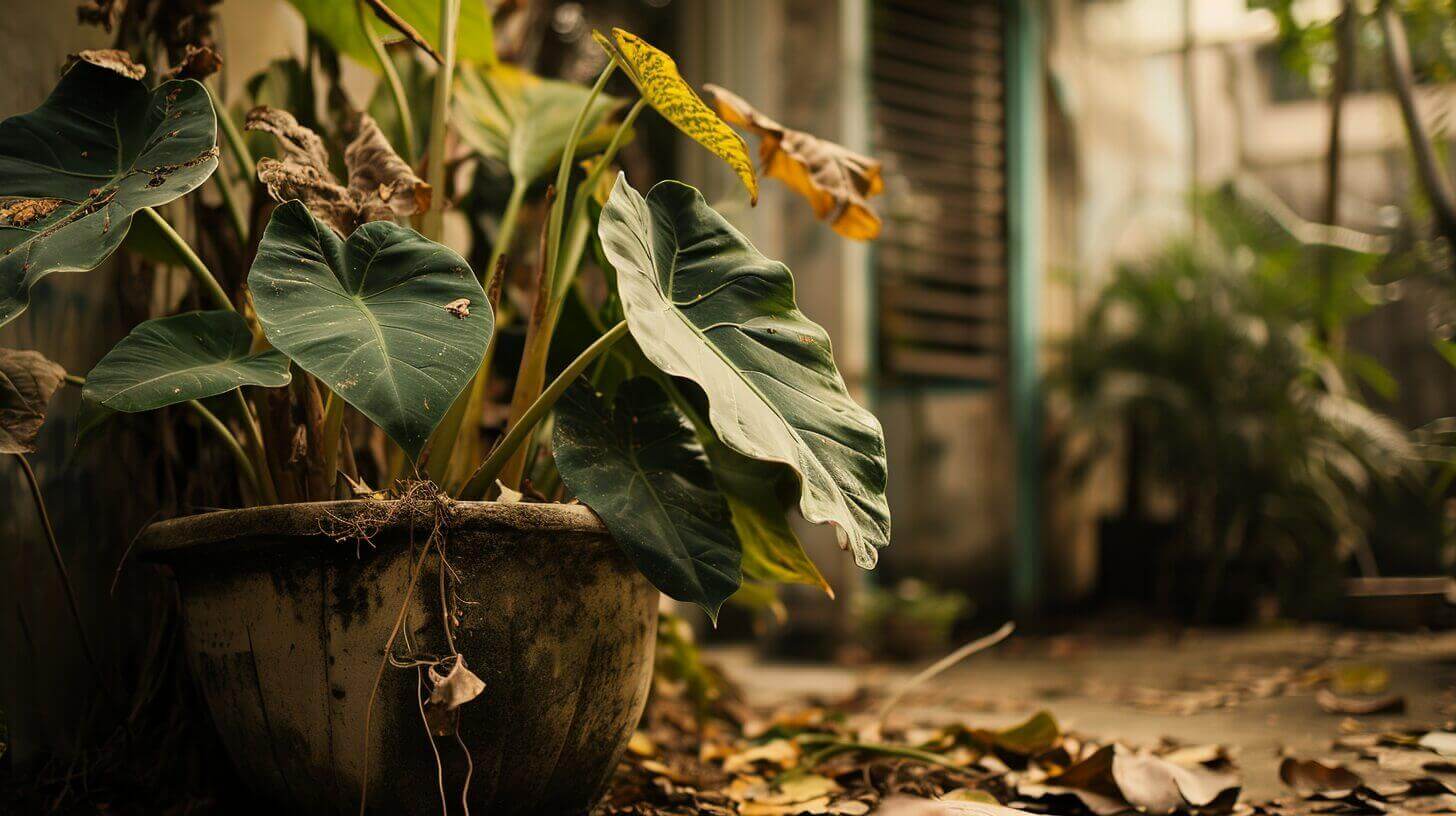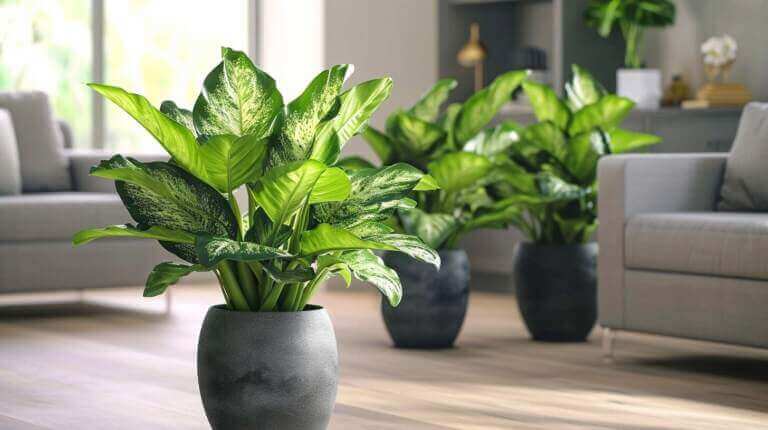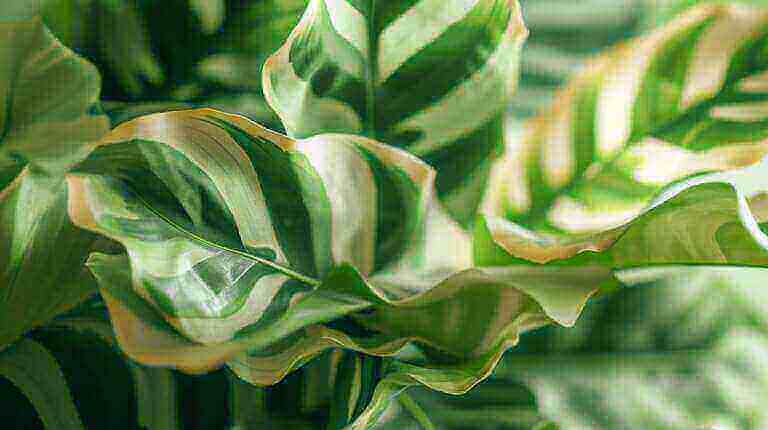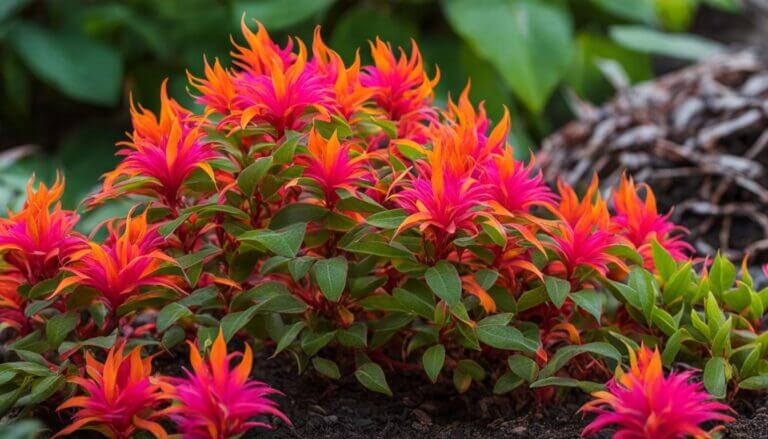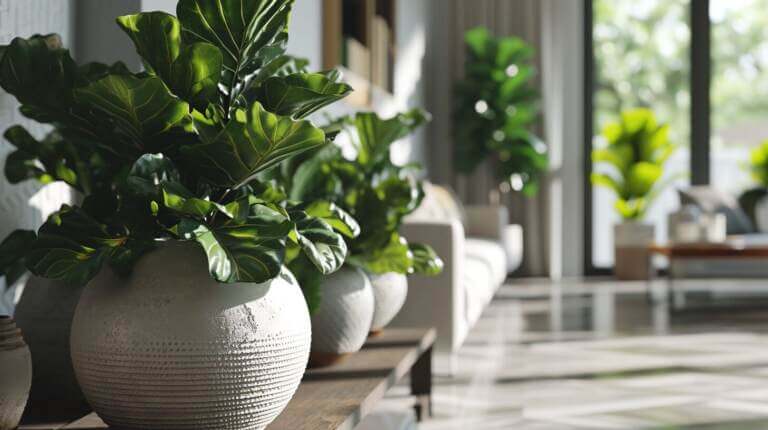How to Save a Dying Elephant Ear Plant: Reasons Your Elephant Ear Plant Dying
Elephant ear tropical plants are known for their large, striking leaves that resemble an elephant’s ear. However, they can struggle to thrive if not properly cared for. If you’ve noticed your elephant ear leaves drooping and turning yellow, don’t give up on them. There are several reasons why an elephant ear plant is dying, including overwatering or underwatering, not getting enough or too much direct sunlight, soil nutrient deficiencies, being root-bound, temperature fluctuations, humidity, fungal infestation, pest infestation, and soil pH imbalance. By identifying the underlying cause and taking appropriate steps to address it, you can revive your dying elephant ear indoor plant and bring it back to health.
Key Takeaways:
- Proper care and attention can help revive a dying elephant ear plant.
- Common issues include overwatering, underwatering, lack of sunlight, soil nutrient deficiencies, being root-bound, temperature fluctuations, fungal infestations, pest infestations, and soil pH imbalance.
- Addressing the specific issue and taking appropriate steps can help bring the plant back to health.
- Ensure proper watering, sunlight exposure, soil nutrition, and protection from temperature fluctuations, pests, and fungal infections.
- Regularly monitor the plant’s health and make necessary adjustments to ensure its well-being.
Dying Elephant Ear Plant(Overwatering or Underwatering)
Overwatering or underwatering can have detrimental effects on the health and vitality of an elephant ear plant. Overwatering can lead to root rot, which occurs when the roots are constantly saturated with water, leading to the decay of the root system. On the other hand, underwatering can cause the plant to wilt and become dehydrated, as it does not receive enough water to sustain its growth.
To revive an overwatered or underwatered elephant ear plant, it is important to address the root cause of the issue. Start by checking the soil’s drainage capabilities. If the soil does not drain well, the excess water can accumulate around the roots, leading to root rot. Ensure that the pot or container has proper drainage holes, and consider adding perlite or coarse sand to improve the soil’s drainage.
Adjusting your watering schedule and volume is also crucial in saving a dying elephant ear plant. Monitor the moisture level of the soil and water the plant only when the top inch of soil feels dry to the touch. During the growing season, the plant may require more frequent watering, while in the dormant period, it will require less water. Remember to always water thoroughly, allowing water to flow out of the drainage holes, and avoid waterlogging the plant.
In severe cases of root rot or dehydration, repotting the plant into a larger container with fresh, well-draining soil can help revive the root system. Gently remove the plant from its current pot, carefully inspect the roots, and trim away any rotten or damaged roots. Place the plant in the new container, ensuring that the roots are spread evenly and covered with fresh soil. Water the plant lightly following the repotting process and continue to monitor its moisture levels to prevent any further issues.
Elephant Ear Leaves Turn Yellow(Lack of or Too Much Direct Sunlight)
One of the common issues that can contribute to a dying elephant ear plant is the lack of or too much direct sunlight. These plants thrive in bright, indirect sunlight, but prolonged exposure to direct sunlight can lead to leaf scorch, dehydration, and leaf tip burn. On the other hand, insufficient sunlight can hinder the plant’s ability to photosynthesize effectively.
To address this issue, it is important to ensure that your elephant ear plant is receiving the right amount of sunlight. Expose the plant to direct sunlight for 3 to 5 hours each day, preferably during the morning or late afternoon when the sun is not too intense. If your plant is not receiving sufficient sunlight, you can supplement it with artificial lighting or consider moving it to a brighter location in your home or garden.
It’s also worth noting that elephant ear plants can benefit from a period of acclimation when transitioning from low light to higher light conditions. Gradually increase the amount of sunlight your plant receives over a few weeks to prevent shock and leaf damage.
Signs of Sunlight Related Issues
It’s important to be able to recognize the signs of sunlight-related issues in your elephant ear plant. If the plant is not receiving enough sunlight, you may notice stunted growth, smaller leaves, and a lack of vibrancy in the foliage. On the other hand, if the plant is exposed to too much direct sunlight, you may observe scorched or browned leaf edges, yellowing leaves, and overall wilting.
Elephant Ear Plant Dying(Lack of Nutrients)
One of the main reasons why an elephant ear plant may be dying is due to soil nutrient deficiencies. When the plant lacks essential nutrients, it can result in yellowing leaves and poor overall growth. Recognizing the signs of nutrient deficiencies is crucial in order to provide the proper care and revive your dying plant.
To determine the specific nutrient deficiencies in your elephant ear plant, it is recommended to use a soil testing kit. This will help identify which nutrients are lacking in the soil and guide you in selecting the appropriate fertilizer or organic matter to replenish them. Common nutrient deficiencies in elephant ear plants include nitrogen, potassium, and iron.
When applying fertilizer or organic matter, it is important to follow the instructions provided and apply the correct amount. Over-fertilization can have adverse effects on the plant and may lead to further damage. Additionally, ensure that the fertilizer or organic matter is evenly distributed around the plant’s root zone to promote uniform nutrient uptake.
| Nutrient | Signs of Deficiency | Recommended Fertilizer or Organic Matter |
|---|---|---|
| Nitrogen (N) | Yellowing leaves, stunted growth | Slow-release nitrogen fertilizer, compost |
| Potassium (K) | Yellowing between leaf veins, weak stems | Potassium-rich fertilizer, banana peels |
| Iron (Fe) | Yellowing leaves with green veins | Iron chelate, compost |
Regularly monitoring the nutrient levels in your elephant ear plant’s soil and providing the necessary nutrients will help prevent deficiencies and keep your plant healthy and vibrant. Remember to observe your plant’s response to the fertilizer or organic matter applied and make adjustments accordingly. With the right care and attention, you can revive your dying elephant ear plant and enjoy its magnificent foliage once again.
Reviving a Root Bound Elephant Ear Plant
Root-bound conditions occur when an elephant ear plant outgrows its current pot, leading to limited space for root growth. This can hinder the plant’s ability to absorb nutrients and water effectively, resulting in a decline in health. To save a root-bound elephant ear plant, repotting it into a larger container with fresh soil is crucial. This provides the plant with ample room for root expansion and promotes better nutrient uptake.
When repotting, gently loosen the roots to untangle them and stimulate growth. Pruning some of the roots can also help, especially if they are circling around the root ball. This encourages the growth of new and healthier roots. It’s essential to choose a pot with good drainage to prevent waterlogging, as excessive moisture can further damage the plant’s roots.
Repotting Steps for a Root Bound Elephant Ear Plant
- Carefully remove the plant from its current pot, taking care not to damage the roots.
- Inspect the roots for any signs of rot or disease. Trim away any dark or mushy roots.
- Select a new pot that is 1-2 sizes larger than the current one, ensuring it has drainage holes at the bottom.
- Place a layer of fresh, well-draining potting soil at the bottom of the new pot.
- Position the plant in the center of the pot and fill in the gaps with more soil, gently pressing it down to eliminate air pockets.
- Water the plant thoroughly and allow any excess water to drain away.
- Place the repotted elephant ear plant in a location with bright, indirect sunlight to aid in its recovery.
By repotting a root-bound elephant ear plant, you give it a chance to thrive once again. The additional space and fresh soil provide the plant with the nutrients and growing conditions it needs to regain its vitality. Remember to monitor the plant’s watering needs, ensuring the soil remains evenly moist but not overly saturated. With proper care and attention, your elephant ear plant will bounce back and continue to grace your indoor or outdoor space with its beautiful foliage.
Temperature Fluctuations and Other Factors
When it comes to saving a dying elephant ear plant, temperature fluctuations can play a significant role. These plants prefer warm temperatures and are sensitive to cold drafts or sudden temperature changes. Exposure to chilly conditions can lead to leaf discoloration, causing leaves to turn yellow or turn brown.
In addition to temperature fluctuations, fungal infestations and pest infestations can also contribute to the decline of an elephant ear plant. Fungal infections, such as root rot, can weaken the plant’s roots and hinder its ability to absorb nutrients and water. Pest infestations, such as aphids and spider mites, can further stress the plant and cause damage to the leaves and stems.
Lastly, an imbalanced soil pH can affect nutrient absorption and ultimately lead to leaf death. Elephant ear plants thrive in soil with a pH level between 5.5 and 6.5. If the soil pH is too acidic or alkaline, it can disrupt the plant’s ability to take in necessary nutrients for growth.
To save a dying elephant ear plant, it’s important to protect it from temperature fluctuations by keeping it in a warm, stable environment. If you suspect a fungal or pest infestation, take appropriate measures to treat the issue promptly. Additionally, regularly test the soil pH and make adjustments using pH-balancing products if necessary. By addressing these factors, you can increase the chances of reviving your struggling elephant ear plant.
FAQ
What are the reasons why an elephant ear plant may be dying?
Elephant ear plants can die due to overwatering or underwatering, lack of or too much direct sunlight, soil nutrient deficiencies, being root-bound, temperature fluctuations, fungal infestation, pest infestation, and soil pH imbalance.
How can I revive an overwatered or underwatered elephant ear plant?
To revive an overwatered or underwatered plant, check for soil drainage issues, adjust your watering frequency and volume, and consider repotting into a larger container with fresh soil.
How much sunlight does an elephant ear plant need?
Elephant ear plants require bright, indirect sunlight. Prolonged exposure to direct sunlight can cause leaf damage, while too little sunlight can affect the plant’s ability to photosynthesize.
Why are the leaves of my elephant ear plant turning yellow?
Yellow leaves with green veins can indicate soil nutrient deficiencies. Use a soil testing kit to determine the specific deficiencies and replenish the soil with the appropriate fertilizer or organic matter.
What should I do if my elephant ear plant is root-bound?
If your elephant ear plant is root-bound, repot it into a larger container with fresh soil and ensure good drainage. Pruning the roots slightly can also help promote healthy growth.
How can I protect my elephant ear plant from temperature fluctuations and other factors?
Protect your elephant ear plant from cold drafts and sudden temperature changes. Treat any fungal or pest infestations promptly, and ensure the soil pH is within the preferred range of 5.5 to 6.5.

